Lviv and Western Ukraine: The View From Israel
By Shimon Briman
In the heart of the former Jewish ghetto in Lviv, on Gazova Street, I am watching the ribbon cutting at the opening of the Honorary Consulate of Israel in Western Ukraine.
I can hear the pro-Israel words of friendship from Lviv Mayor Andriy Sadovyi, Governor Oleh Synyutka, and Deputy Foreign Minister Serhiy Kyslytsya. In response, there are pro-Ukrainian statements from the Israeli ambassador to Ukraine Eliav Belotserkovskiy, the Knesset deputy Sofa Landwehr, and Tali Ploskov.
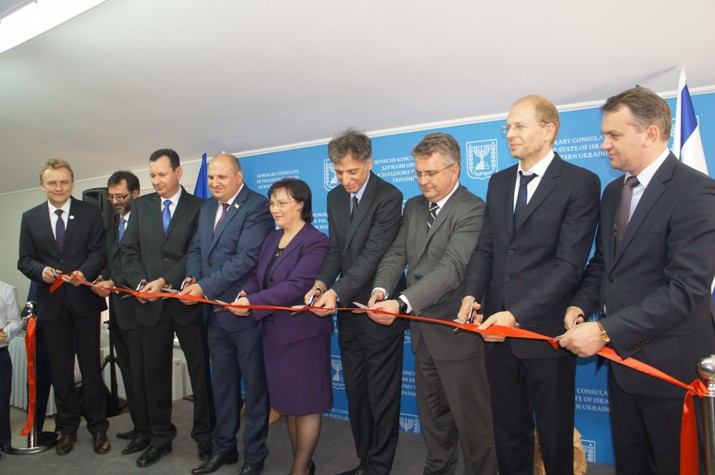
Opening ceremony of Israel's Honorary Consulate in the Western Ukrainian city of Lviv last year.
A Jewish wedding atmosphere prevails, where “the groom” is the Honorary Consul of Israel, the successful Ukrainian businessman Oleh Vyshnyakov, and “the bride” is the entire Western Ukraine.
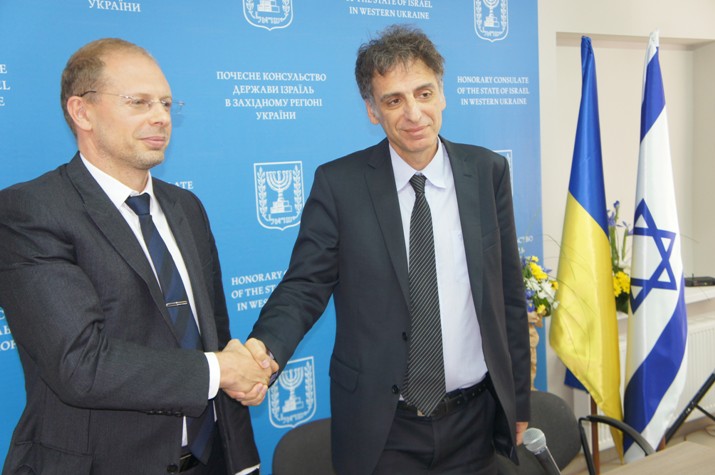
Oleh Vyshniakov, Israel's honorary consul in Lviv (left) and Israel's ambassador to Ukraine Eli Belotsercovsky (right) during the opening of the honorary consulate.
Vyshnyakov is modest and taciturn, as it should be with the “newly wed.” The Ukrainian parliamentary deputy Borislav Rosenblatt congratulates the “newlyweds.” His colleague, MP Georgiy Logvinskyi, who during his youth lived in Israel for several years, expresses wishes in good Hebrew for the two countries and peoples to have a happy life together. The Ukrainian Ambassador to Israel Genadiy Nadolenko and the Head of the Eurasia-1 Department of the Israeli Foreign Ministry Yakov Livne are smiling as happy parents.
With an ancient blessing, the wise Lviv Rabbi Mordechai-Shlomo Bold is attaching a mezuzah to the door—the parchment with citations from the Torah. There are hundreds of guests, cameras, and flashes. Before our very eyes is born the new reality of Ukrainian-Jewish cooperation. Police guard the guests of the Honorary Consulate. I watch how the flags of Ukraine and Israel are waving in the wind and I understand that it was impossible seventy years ago in this district of the city to see the trident peacefully together with a six-pointed star. The head of the Ukrainian Auxiliary Police of Lviv, Major Pitulay, reported to the Germans on the results of one day like this: “During the campaign against the Jews on 25 March 1942, 2254 Jews were transferred to the concentration camp,” that is, on the train to Belzec, to the gas chambers.
The events in Lviv at that time changed the city forever. People were hunted down even in the sewers underground. The occupiers killed almost 140 thousand Jews—more than 35 percent of Lviv ‘s inhabitants. I walk along the streets of today’s city and ask myself if people in Lviv remember the “lost Atlantis” of Jewish Lviv? Do they want to remember?
On the corner of Rappoport and Sholem Aleichem streets, I see the Lviv market that is active atop the medieval Jewish cemetery hidden under asphalt. At first the Nazis smashed the tombstones, and then they were totally destroyed after the second coming of the Communists. They say that in 1991, when the Lenin monument in Lviv was pulled down, ancient Jewish tombs were found in the pedestal.
Near the Opera Theater I find the spot from where a German photographer took a picture of the first day of occupation in June 30, 1941. In that photograph one can see Jews are on their knees and they are cleaning the area in front of the theater, and a mob of city inhabitants surrounds and mocks them. I look up and see the word “Moses” on the theater. This is the word from the poster for the Ukrainian opera by Myroslav Skoryk based on the novel of Ivan Franko.
The tourist from Israel walks to the Square of Three Synagogues that became the square of three restaurants. The place the Nazis bombed—the Great Synagogue and the House of Scientists at the end of Staroyevreyska Street—are filled with restaurant tables. Hundreds of tourists dine peacefully, without even knowing that they are sitting on ruined prayer houses. The ruins of the synagogue of the sixteenth century “Golden Rose,” which was blown up by the Nazis in 1941, are just behind the fence.
The one working synagogue on Brativ Mikhnovskyh Street was saved by…the horses. Stables for the station cabs were located there when the Red Army arrived in September 1939. The Nazis continued this “horse parking” and did not touch the building with the amazingly bright frescoes.
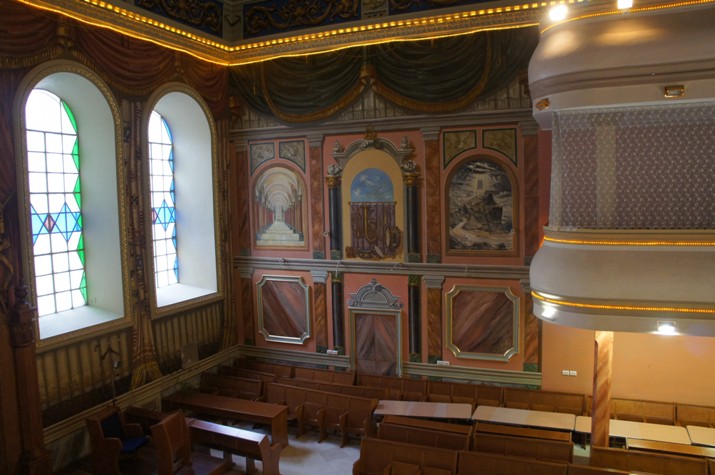
Interior of the synagogue on Lviv's Brativ Mikhnovskih Street.
Lviv on the one hand wants to increase the flow of Israeli tourists, and also any other foreign tourists who would be interested in landmarks of Jewish history. On the other hand, the city today has almost nothing to offer to such tourists.
There are no signs where the old synagogues were located in the Old City. There are just several pictures around the ruins of the “Golden Rose.” Staroyevreyska Street is full of restaurants and cafés, but it does not have any signs of Jewish presence except for the empty spots for the mezuzah on the doorposts of several houses. The market occupies the location of the old cemetery. And on the site of the former Janowska concentration camp—where there is still a working prison—there is still no worthy memorial.
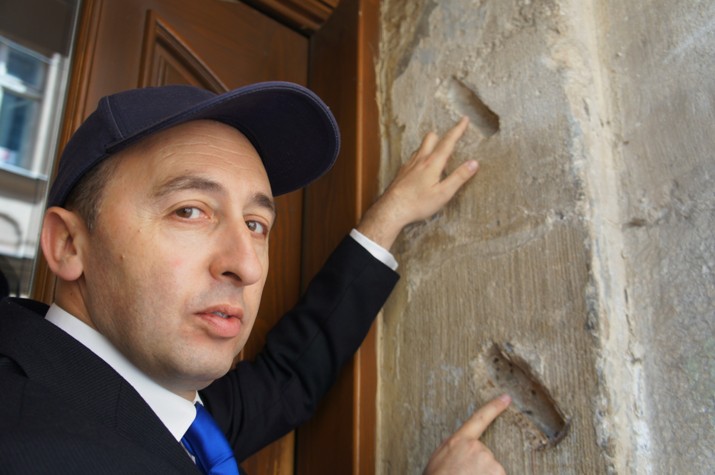
Empty spaces left after the removal of a "Mezuzah" - a piece of parchment with quotations from the Torah -- at the entrance of a former Jewish house on Staroyevreyska Street in Lviv.
The mayor’s office of Lviv is not to blame. They wanted to implement the results of the international competition for the renovation of Jewish landmarks held in 2010-2011. Germany was then ready to finance work on three projects: “Square of Three Synagogues,” the old Jewish cemetery, and the Janowska camp. The implementation of these projects was not possible because of lawsuits from one of the local Jews. Years were spent on the court proceedings, and as a result nothing happened for five years and the Jewish landmarks remain in ruins.
Advertising in Yiddish on a grocery store in the former Jewish district of Lviv (on today's Kulisha Street).
I asked the mayor of the city Andriy Sadovyi about this, and he responded that the municipality was and remains an ardent supporter of a decent renovation and memorialization of Jewish sites. In 2015, the city budget already had money for the conservation of “Golden Rose” ruins because they are exposed to wind and rain without any protection.
Despite the visual emptiness among the sites of Jewish memory, the city has taken a number of steps to preserve its Jewish past. The municipality sponsored the publication of a guide about Jewish Lviv that is available for tourists at the information center in Market Square. With the support of the German government and some community groups, information plaques have been installed in the ravine behind the Janowska prison.
It is useful for Lviv to learn from Prague and Krakow, which both restored their old Jewish quarters of Josefov and Kazimierz and attracted tourists. Lviv has much to do so that its memorable places look just as worthy. It is not only about tourism, but also about humanity, and the memory of people whose energy and talents filled Lviv.
Fortunately, Mayor Sadovyi is striving to do this and I hope that the new Consulate of Israel will now also help.
The Honorary Consul of Israel Oleh Vyshnyakov has set himself to task. Direct flights between Tel Aviv to Lviv were established through his initiative. Israeli experts held seminars for psychologists about the rehabilitation of victims in the ATO [anti-terrorist operations in eastern Ukraine, editor’s note] zone. In October 2015 Vyshnyakov conducted an international Ukraine-Israel business forum in Lviv held under the patronage of the Foreign Minister of Ukraine Pavlo Klimkin.
The International Jewish educational project “Limmud” had a brilliant conference in Lviv in 2014 and repeated this success in the fall of 2015 in the City of the Lion.
Israel closed the honorary consulate in Russian-annexed Crimea and opened one in the “den of Bandera.” [Stepan Bandera, leader of the Organization of Ukrainian Nationalists, or OUN, editor’s note] This most clearly shows that my country does not believe the myths about Ukraine.
Zolochiv
My trip to Zolochiv—a regional center of Lviv region—was marked by mixed feelings. The picturesque hills of Prykarpattia and the ancient Polish Castle dating from the 17th-18th centuries evoked positive feelings, but the historical facts forced me to think about the tragic past against the background of this beauty.
Zolochiv is important in the context of Ukrainian-Jewish relations. The well-known Hasidic dynasty of Naftali Herz Imber—the future creator of the anthem of the Zionist movement and the State of Israel—came from here. Roald Hoffman, the future American winner of the Nobel Prize in Chemistry, was born here. He also lost relatives in the ghetto and was saved by Ukrainians.
In July 1941 a terrible pogrom broke out here, initiated by the local “Ukrainian National Committee” under the leadership of N. Antonyak. The Germans supported the pogrom with weapons and personal participation.
Two tragedies are intertwined with Zolochiv castle. With the arrival of the Soviets, an NKVD secret police prison was organized there. In late June 1941, before retreating, the guards shot all the prisoners—more than 700 people. Almost immediately after the entry of the Germans into the city, a Ukrainian militia was quickly formed and it gathered a crowd of Jews into the castle on July 3, forcing them to dig out the bodies with their bare hands. Ukrainian-language posters accusing the Jews for the NKVD crimes were hung in the city.
A wild looting of Jewish homes occurred in the city; neighbors robbed and beat their neighbors. There were other Ukrainians. Mykola Dyuk would hide for eighteen months in the school annex the family of the very young Roald, the future world famous scientist and Nobel Prize winner.
Thirty five hundred Jews were driven into Zolochiv Castle and killed in a pogrom perpetrated by the Ukrainians and Germans together. The killed were buried in two pits—one inside the courtyard, and another behind the walls of the castle.
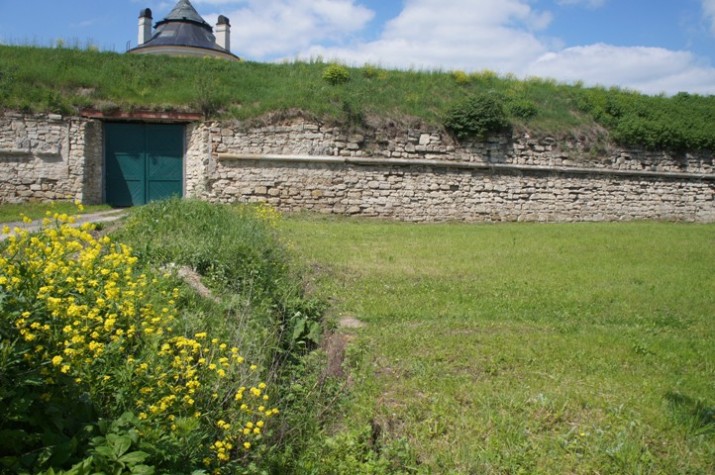
Zolochiv Castle, with grass covering the site of a mass grave of murdered Jews.
Seventy-four years later I am walking in the beautiful courtyard of the Zolochiv castle. I see flowers, sculptures, and the Chinese pavilion in front of me. In the main building of the castle-museum there is an exhibit in memory of the victims of the NKVD prison. On the list of those who were shot there are Ukrainian last names but also two-dozen Jewish names.
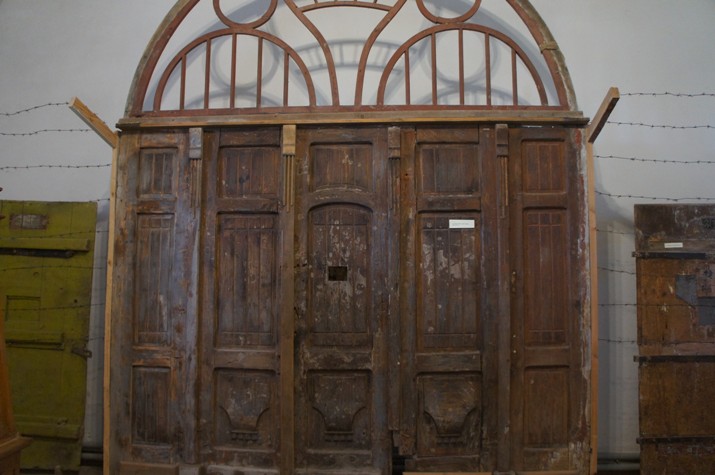
Former gates of a NKVD prison at an exposition at Zolochiv Castle.
Here are the prison gates with a small window. I look into it and recoil. An NKVD officer is painted on the wall and looking back at me. The officer has explicit Semitic facial features, although in the exhibition it is indicated that the ethnic Russian Kharitonov and others gave the commands for the executions in the prison. I would like to ask the Zolochiv museum staff why the artist depicted a Jew in the form of a villainous security officer. Did he want to repeat the 1941 accusations against the Jews?
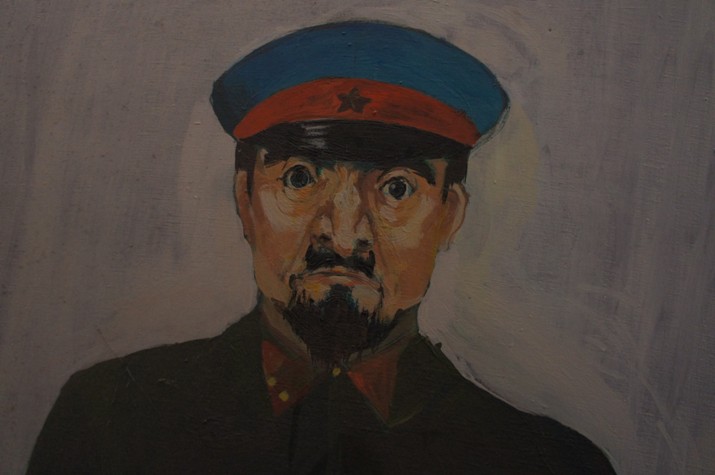
The figure of an NKVD officer with Jewish features, in the window of the NKVD prison at an exhibition at Zolochiv Castle.
I ask an employee of the castle if there is there any sign on the second, biggest grave of those who were killed during the pogrom of Jews, behind the walls of the castle. And I hear an answer that assaults my ears: “There is no sign; the Jewish community did not place one.” It is stated calmly and confidently as if it goes without saying that “the Jewish community” (which does not even exist in the city) should be busy with the dead Jews. As if the thousands of shot Jews are not part of the population of Zolochiv, and it is not the duty of the local authorities to commemorate the memory of their dead fellow citizens.
Today in Zolochiv there is some kind of “competition of victims” with an emphasis on their own Ukrainian victims. It is apparently unpleasant to report on the Jews because you will then have to tell the truth and admit that among the killers were people from Zolochiv. The museum exhibit notes about seven hundred peaceful civilians who were killed in the dungeons of NKVD, but it fails to mention that thousands of residents of the same beautiful town who were Jews were killed in the same place a few days later with axes, knives, bullets, and grenades. I am walking along the castle walls and go to the empty spot covered with hay. Thousands of the killed are here underneath me, but there is not even a stone. I close my eyes with my hand and recite “Shema Yisrael.” This is the only thing I can do now to remember the martyred. Sometime in the middle of the eighteenth century, Rabbi Yechiel Michael from Zolochiv wrote one of the most famous Hasidic “nigunim”—the melody “The Awakening of Great Charity.” The founder of Hasidism Rabbi Israel Baal Shem Tov heard this nigun before his death, and promised that for everyone in all generations who would sing this song, the angels would carry this song to him in Heaven and he would also start singing the melody so as to attract flows of great charity to the one who is singing on earth.
You will not hear this melody in Zolochiv anymore. There is no one to sing it. But in Israel and in the United States there are groups and fraternities of Zolochiv Jews and their descendants. There is the second generation of those who miraculously survived. There are meetings being held and books being published about the memories of a city that once was half-Jewish.
Later, when I returned to Israel, I contacted Professor Hoffman and shared my impressions of what I saw in Zolochiv with him. The Nobel laureate writes in his reply: “It is really sad that the local population does not recognize their role in the killings during the war. However, memoirs and books exist, and there are some Ukrainian historians who are brave enough to write about it.”
Hoffman shares his plans. In the fall he wants to visit Zolochiv and the place of his salvation. The famous scientist is interested not only in chemistry. He recently wrote an autobiographical play about his survival and on Ukrainian-Jewish relations. A translation of the play into the Ukrainian language is now being prepared. Perhaps some theater group in Ukraine will decide to perform this play by the Nobel Prize winner?
Дрогобыч и Жовква
The trips to the south and north of Lviv were short but intense. Drohobych for me is the city of Bruno Schulz, just as Vitebsk is the city of Marc Chagall. The pearl of Drohobych—Bruno Schulz's famous frescoes from the villa of the Gestapo officer—were waiting in the city’s Museum of Art. An international scandal between Ukraine and Israel erupted as a result of the frescoes, half of which remained at the Yad Vashem Museum while the others were returned to Drohobych.
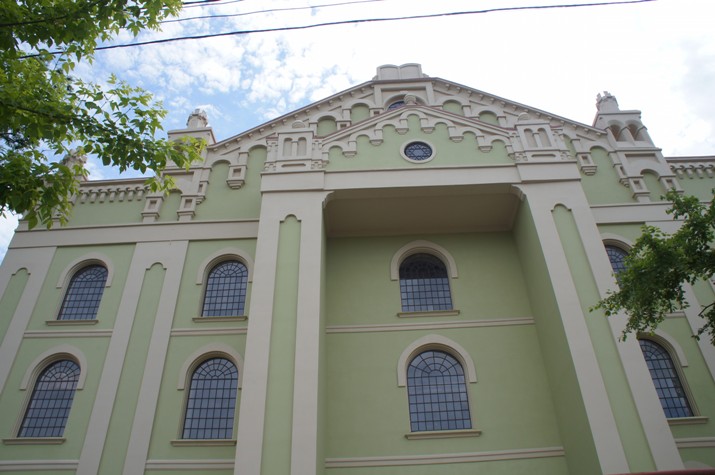
Synague in Drohobych.
A very interesting and detailed exposition in the local museum is dedicated to Bruno Schulz. Based on the narration by the intelligent guardian of the museum, it was obvious that she understands and appreciates the importance of the Polish-Jewish writer and artist in the context of European culture.
I was struck by one characteristic detail in the Schulz exposition: the equivalent pairing of the Soviet and Nazi regimes. In the exhibition stands I read: “From the end of 1939 to early 1943, the population of Drohobych was almost halved, by 45 percent.” That is, the Soviet deportations and Hitler’s genocide look like “birds of a feather.” But at the same time it erases all the unique features of the Holocaust. Unlike other cities of the Lviv region, Drohobych can soon proudly introduce a completely renovated Great Synagogue to the tourists. The prayer building is one of the largest in Eastern Europe and was revived, as they say, with the money of Moscow oligarch Viktor Veskelberg, a native of Drohobych.
Zhovkva and Drohobych are linked by giant portraits of Stepan Bandera in the town centers. In Drohobych, a huge portrait of the OUN leader hangs in the main square opposite the Town Hall, where in 1940 a gigantic portrait of Josef Stalin drawn by Bruno Schulz was hung. The rays of the sun beam out of Bandera’s head on Zhovkva’s district administration building. It is on the same façade where once a portrait of Lenin was hung.
I find the old “gates”—the gates of Zhovkva that again repeat the view of a German photographer. In a certain shot in July of 1941, the gate was decorated with the poster that read: “Heil Hitler! Glory to Hitler! Glory to Bandera!” Now there is no agitation at the gate.
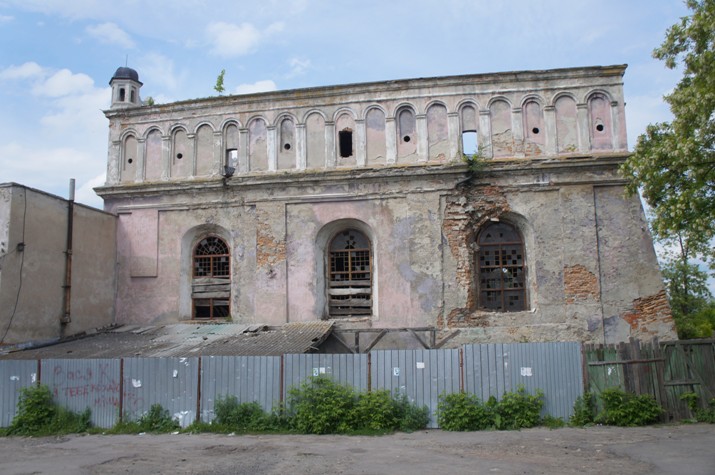
Synague in Zhokva.
Zhovkva’s synagogue, a pink beauty of the seventeeth century, is a rare example of “the fortress synagogue” and offers a painful impression. It is terrible to observe this potential “pearl of tourism.” The building-masterpiece has been in ruins for many years. The windows are shattered and the walls are crumbling. On the fence around the synagogue there is a single election campaign poster for [Ukrainian Prime Minister] Arseniy Yatsenyuk and advertisements for building materials.
I return to Lviv to fly home to Israel. I carry conflicting impressions of Western Ukraine with me, a Western Ukraine that is searching for itself and trying by all means to prosper and open up to the world without losing its national identity.
I want to say to the Galicians, and also to all the Ukrainians who are interested in co-operation with Israel and Israelis, that we are open to dialogue. But to start a relationship with a clean slate, we must honestly tell each other the truth of history no matter how bitter it may have been.
Let us visit each other and promote tourism and high-tech. Let us teach Ukrainian cows feeding on their rich black soil to provide not 4,000 liters of milk per year, but instead 12,000 liters like Israeli cows do in the Negev desert. Ask how and Israeli experts will tell you. Israel returns to Lviv and Western Ukraine to implement a historic opportunity for political, business, and human partnership.
Shimon Briman is an Israeli journalist and historian. He graduated from the History Department of Kharkiv National University (M.A.History, 1993) and specialized in the study of the history of Jews in Ukraine, the Russian Empire, and the Soviet Union. He has lived in Israel since 1996. As a journalist, he has published thousands of articles in the popular media of Israel, Ukraine, and the United States, and has also written dozens of articles in academic journals. Shimon Briman is the author of the long article “Kharkiv” in the Brief Jewish Encyclopedia (Jerusalem). He pays particular attention to studying the media coverage of Ukrainian-Jewish relations and contemporary co-operation between Ukraine and Israel. He is an expert on Ukraine for the Jerusalem Post, Israel’s leading English-language newspaper, and Israel’s television Channel 9.
Translated by: Olesya Kravchuk, journalist, interpreter
Additional translation and editing by Peter Bejger



















